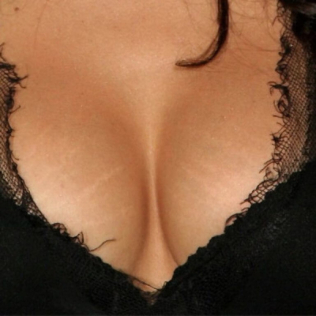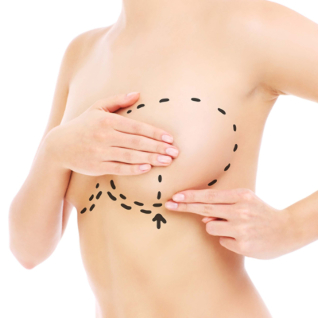
Breast ptosis or sagging is an aesthetic problem that worries many women. It adds self-confidence and sexuality.
If a woman is worried about this, embarrassed in front of her husband or boyfriend, you may want to try a breast lift.
This procedure should not be confused with breast augmentation with implants. The purpose of the lift is to eliminate ptosis, which provides the natural flexibility of the female breast.
What is this procedure, what is it called?
Breast augmentation is mastopexy.The procedure involves reshaping the mammary glands, giving them natural flexibility and an attractive appearance without the use of implants. Surgery is performed with minimal surgical intervention, under local or general anesthesia.
The degree of ptosis plays an important role in your choice. The disease has 4 degrees. Appropriate measurements are made to make an accurate diagnosis. The degree of sagging is determined by the distance between the breast drive and the nipple.
Help!Ptosis is in stages 1, 2, 3, and 4 and is measured by the distance between the breast fold and the nipple. The 1-2 cm descent is not critical and refers to the 1st degree.
If the nipple is at least 8 cm below the breast augmentation, place a grade 4 ptosis. Here, surgeons have to cut off large amounts of skin and adipose tissue, and this will be impossible without general anesthesia.

Readings
Chest skin is sensitive to any changes in the body. There is no natural muscle frame beneath it that would keep its shape. Therefore, it is difficult to maintain its original form throughout life. The reasons for the shape change are:
- Sharp increase or decrease in weight.The stretched body of the chest loses its elasticity after losing weight and looks flabby.
- Large breast size.Breasts larger than 3 size sag under natural weight.
- Changes in hormonal background.Lack or excess of hormones contributes to breast swelling or "deflation".
- Operations. For example, when a malignant tumor is removed, the glands become asymmetric. In severe cases, the mammary gland empties and sags.
- Cor.A chest without muscle support loses its elasticity in front of the rest of the body.
- Improperly fitted bra.If you don't provide adequate support, your mammary glands will sag prematurely.
- Breastfeeding.Breast glands filled with milk can enlarge 3-5 times. After breastfeeding is complete, it returns to its original size but not its shape.
- Congenital disorders.Breasts may not develop properly from puberty. The only way out is to correct the shape.
Another problem with breast sagging is that it is usually accompanied by stretch marks and sagging skin.
Contraindications, Limitations
Mastopexy is a surgical procedure on the body. Any operation has its own indications and contraindications. This type of operation is not required in many cases:

- pregnancy or planning as all the results of the surgery fade;
- less than 12 months after the end of hepatitis B, this is how much the mammary glands need from lactation; the presence of tumors
- in the chest area;
- acute infectious diseases;
- diabetes mellitus;
- renal failure;
- cardiovascular dystonia;
- under the age of 18 (parental consent and medical urgency required);
- Obesity, which is a consequence of metabolic disorders and can cause complications after surgery.
Before deciding on mastopexy, the positive and possible negative consequences should be considered.
Views
Breast augmentation can be done with or without surgery.In the first case, the method of tissue excision is applied according to different schemes, the second is the effect on the deep layers of the skin. It should be noted that non-surgical methods are best used to prevent ptosis or in its early stages. Operational interventions help solve the problem in more advanced cases.
Endoscopic
Small areas of skin are cut off on the small side of the breast.they show the endoscope and instruments through them. The tissue is cut out from the inside so the surgery will be invisible after the scars have healed.
This is one of the most expensive mastopexy types. The success of this procedure depends on the qualifications and experience of the doctor performing the operation. But the result remains unchanged for 10-15 years. Endoscopic mastopexy can eliminate ptosis of any severity.
Periareolar (circular)
During thissurgery, the doctor will cut off the excess tissue around the areola.This way, you can not only tighten the mammary glands, but also change the diameter of the nipple. Traces of surgery and recovery become invisible.
Disadvantages include a possible effect on breastfeeding. In addition, it is used only with 1 and 2 degree descents. After surgery, some patients noted a loss of nipple sensitivity.
Vertical

During surgery,the surgeon makes incisions above the breast and at the edges to lift the nipple.This method requires minimal intervention in the structure of the mammary glands and causes virtually no complications and maintains the natural shape of the breast. It can also help the nipple contract.
This method is used in the early stages of ptosis. Not to be used if there are already scars on the chest. In addition, it does not help with severely sagging breasts.
Anchor (T-shaped)
Indicated in severe ptosis or uncomfortable large breasts. During theoperation, an anchor or inverted T incision is made in the chest.The surgeon then cuts off the excess tissue and pulls the lower part upwards.
Surgery has a pronounced aesthetic effect and can be repeated until the patient is satisfied with the result. Disadvantages include the use of a large number of cuts. This increases the rehabilitation period and can cause complications.
Laser
This is a relatively new type of raise. It is widely used in the West, but there are few clinics in Hungary with the necessary equipment. The laser can be used to lift and enlarge the breast.You don't need to use a scalpel to do this.
Laser lifting is effective in the early stages of ptosis. About 6 treatments are needed to achieve the desired effect. Perform at intervals of at least 14 days. The procedure does not require the introduction of anesthesia as it is painless. In some cases, discomfort may occur.
Mesothreads
If the breast has lost its previous elasticity and causes internal discomfort to a woman, doctors recommend a procedure for implanting mesothreads. It leaves no marks on the skin and has no complications.
Being in the mammary glands,fibers are gradually overgrown in adipose tissue and have a supportive effect.The fibers work for 6-8 months, after which they are completely absorbed and do not require removal.

Non-surgical methods
For women with grade 1 breast sagging, the method of non-surgical breast augmentation is recommended. They help restore skin elasticity and restore the shape of the mammary glands:
- Myostimulation - electrical impulses sent through connected electrodes restore skin elasticity and eliminate stretch marks.
- Lipolifting - the transfer of adipose tissue from the abdomen and the inside of the thigh to problem areas of the chest. Guaranteed 100% adipose tissue implantation.
- Serum microconductors - triggers the active production of elastin and collagen, accelerates cell renewal, reduces sutures and stretch marks.
- Mesotherapy.
The choice of lift type is also influenced by the degree, asymmetry, and size of the breast extension. The surgeon assesses the general condition and selects the safest and most effective option for each case.
Preparing for plastic surgery
Before seeking permission from a surgeon for breast augmentation,consult with other professionals: a gynecologist, therapist, mammologist, and anesthesiologist.You must pass a number of tests:
- general and biochemical blood test;
- blood test for diabetes mellitus;
- general urine analysis;
- analysis for hepatitis, HIV, syphilis;
- ECG;
- Breast ultrasound;
- mammography;
- fluorography.
You should not smoke, drink alcohol, drink beverages that affect blood density, including oral contraceptives, for 14 days and after the same amount of time before surgery. You also need to give up intense physical activity. Do not consume food immediately before surgery 12 hours before surgery. You can drink tea or water.
How does it happen, dangerous?

How does this work?Mastopexy is safe.It starts with marking the breast. The surgeon marks the incisions and skin areas to be removed with a marker. The patient then receives anesthesia. There are several ways:
- intravenous;
- inhalation;
- local.
Stages of Mastopexy:
- the surgeon makes incisions along the markings;
- further forms the end result and cuts off excess skin and adipose tissue;
- if necessary, the surgeon reduces the circumference of the nipples;
- After that, sutures and antibacterial bandages are applied, drains are inserted (you can learn more about which sutures are and how long they heal after surgery).
Operation time is between 1, 5 and 3 hours.
What happens in the postoperative period?
- The patient recovers almost immediately after surgery.Chest pain begins when we recover from anesthesia. The surgeon should advise on painkillers and antibiotics to be taken in the postoperative period.
- 3 days after mastopexy, the patient is observed in hospital.If no complications arise, you will be released. The physician should evaluate the primary outcome, namely, whether the stitches are starting to tighten and whether there is an asymmetry. After one week, the stitches are removed.
- Edema occurs in the first week after surgery.The chest looks like a stone. In the first month, the swelling persists and bruises may appear. After 1-3 months they disappear completely, you can evaluate the result. During this time, the stitches are completely healed, edema and hematoma are reduced.
- For the first six months, you should wear corrective underwearto help you stay in shape, use ointments that speed up skin regeneration. This facilitates faster delivery of the rehabilitation period.
- You should not visit the bathhouse or sauna for 6 months after the operation,in order not to infect the open sutures. It is forbidden to go to the gym and lift weights - this contributes to the variation of the seams.
Patients who choose mastopexy should also be aware of the possible complications. These include mammary gland pain, bruises and hematomas, swelling at the incision site, tissue inflammation, and loss of sensitivity.
Before and after photos

You can still see what a big breast looks like before and after lifting.
Cost of the procedure
The cost of the service depends on the type of operation, the qualifications of the surgeon and staff, and the condition of the clinic. The price also includes a training program, the purchase of corrective underwear, patches and anesthesia.
Mastopexy offers every woman the opportunity to re-feel her sexuality and allure. However, before deciding on a serious step, you need to study the information about the operation, compare the positive aspects and the potential risks, and only then make the final decision.
Mammoplasty is a type of surgery to correct the shape and size of the breast. The specialist changes the contour and volume of the mammary glands, the shape of the nipples and areoles.


























